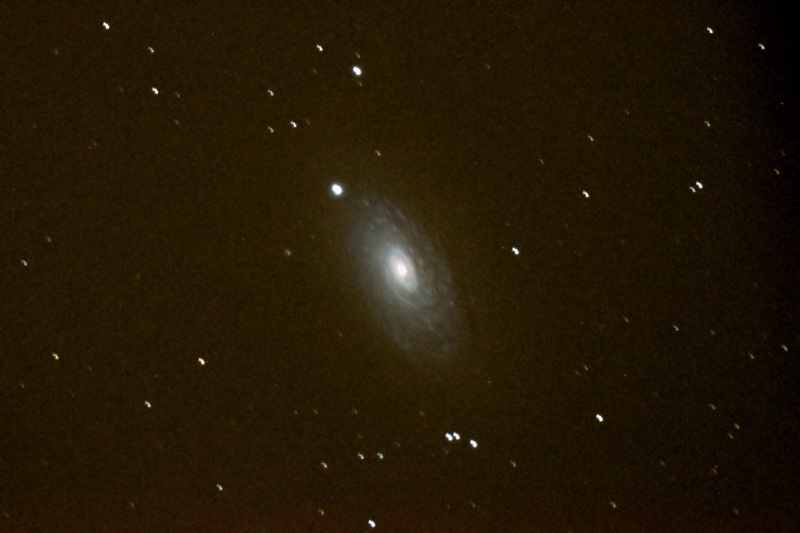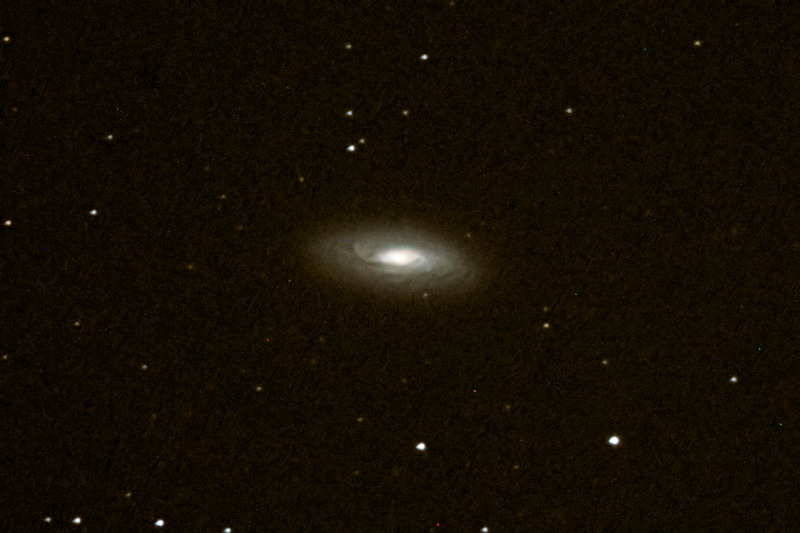
More DSO Imaging: NGC3626, 3132, 4449, 5005, 4038, M106, M63
Posted: 19 February 2012
I opened the observatory Saturday, 18 February, at 1729 MST, 71°F, to clear skies. At 1734 MST, I viewed Venus using 77X. I captured this iPhone 4 afocal image of Venus at 666X with combined orange and moon filters (to reduce the planet's brightness). The image is one frame from a video recording made with the Camera app. The iPhone was mounted on the 8" LX200-ACF using the MX-1 afocal adapter.

Beginning at 1812 MST, I ended imaging and began observing planets. First was Venus, 77X. Then Mercury, 77X and 206X. The view of Mercury was better this night than on the previous session, but it was still too low for good viewing. I tried for Uranus at 1815 MST, but the sky was too bright. At 1822 MST, viewed Jupiter at 77X and 206X. Four moons were visible and the Great Red Spot was rotating into view. At 1827 MST, finally viewed Uranus, 77X and 206X.
At 1850 MST, I slewed to M42 (Great Orion Nebula) and began waiting for twilight to end. While waiting, I used Observer Pro on the iPhone to check for some good DSOs to observe. I selected eight galaxies and one planetary nebula. I observed these and several other DSOs at 77X from 1916 MST until 2236 MST. I observed:
M42
NGC2403 - nice galaxy (previously imaged)
NGC2207 - faint galaxy
M106 - really nice galaxy
NGC4449 - nice irregular galaxy
NGC5005 - nice galaxy
NGC3626 - small faint galaxy
NGC4565 - nice galaxy (previously imaged)
NGC3628/M65/M66 - Leo Triplet of Galaxies, all three in the same FOV at 77X (previously imaged)
M105/NGC3384/NGC3389 - nice tight group of galaxies (previously imaged)
NGC3132 - nice small planetary nebula
M63 - Sunflower Galaxy
I also observed Mars at 77X, 133X, 206X, and 364X. Seeing was not very good but the North Polar Cap and some surface dark areas were visible.
At 2236 MST, I began DSO imaging with the D7000 DSLR at prime focus + Off-Axis Guider. First, SYNCed on Regulus. Then did a focus test on Regulus using the Bahtinov Mask. I continued imaging until 0035 MST. Here are the DSOs I imaged, edited in Aperture and GraphicConverter, with noise reduction done in Neat Image:
NGC3626, galaxy, 5 minutes, guided, ISO 6400, slight crop

NGC3132, Eight-Burst Planetary Nebula, 30 seconds, unguided, ISO 6400, slight crop

M106, galaxy, 5 minutes, guided, ISO 6400, full-frame

M63, Sunflower Galaxy, 5 minutes, guided, ISO 6400, slight crop
(guiding not precise, will redo on a future session)

NGC4449, irregular galaxy, 5 minutes, guided, ISO 6400, slight crop

NGC5005, galaxy, 5 minutes, guided, ISO 6400, slight crop

NGC4038, Antennae Galaxies, 5 minutes, guided, ISO 6400, slight crop

At 0042 MST, viewed NGC4038 (Antennae Galaxies), 77X. The galaxies were faint but the structure was clearly seen.
I then viewed Mars again at 77X, 133X, 206X, and 364X. Seeing was still not good even with Mars very high in the sky. I added the moon filter, which helped somewhat. I then viewed Saturn at 77X, 133X, 206X, and 364X. It is always a nice view. This was a six planet night.
At 0104 MST, I viewed M51, the Whirlpool Galaxy, 77X and 133X. Lovely view with lots of structure visible. I then viewed the M101, M81, and M82 galaxies at 77X. Nice to see them again.
Closed the observatory at 0129 MST, 42°F. A good and fun 8 hour session.
Go to the previous report.
Return to the Cassiopeia Observatory Welcome Page.